
Ghent is a city and a municipality in the Flemish Region of Belgium. It is the capital and largest city of the East Flanders province, and the third largest in the country, after Brussels and Antwerp. It is a port and university city.
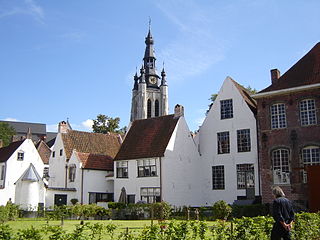
A beguinage, from the French term béguinage, is an architectural complex which was created to house beguines: lay religious women who lived in community without taking vows or retiring from the world.

The Beguines and the Beghards were Christian lay religious orders that were active in Western Europe, particularly in the Low Countries, in the 13th–16th centuries. Their members lived in semi-monastic communities but did not take formal religious vows; although they promised not to marry "as long as they lived as Beguines", to quote an early Rule of Life, they were free to leave at any time. Beguines were part of a larger spiritual revival movement of the 13th century that stressed imitation of Jesus' life through voluntary poverty, care of the poor and sick, and religious devotion.

The Holy Corner or Old Saint Elisabeth is a beguinage in Ghent, Belgium. It is one of three beguinages in the city – the other two are the new Saint Elisabeth beguinage in the suburb of Sint-Amandsberg and Our Lady Ter Hooyen in the Lange Violettenstraat. Both Saint Elisabeth beguinages were named after Elisabeth of Hungary, also known as Saint Elisabeth of Thuringia.

Oostakker is a sub-municipality of the city of Ghent located in the province of East Flanders, Flemish Region, Belgium. It was a separate municipality until 1977. In 1872, Sint-Amandsberg was detached from Oostakker. In 1900, 1920 and 1927, parts of the original municipality were already annexed to Ghent. On 1 January 1977, the municipality of Oostakker was merged into Ghent.
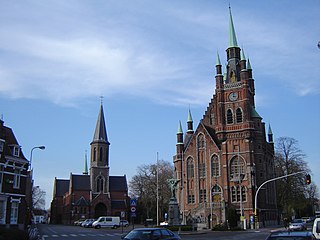
Sint-Amandsberg is a sub-municipality of the city of Ghent located in the province of East Flanders, Flemish Region, Belgium. The municipality of Sint-Amandsberg was formed in 1872, when it was detached from the municipality of Oostakker. In 1876 and 1900, parts of the original municipality were already annexed to Ghent. On 1 January 1977, the municipality of Sint-Amandsberg was merged into Ghent.
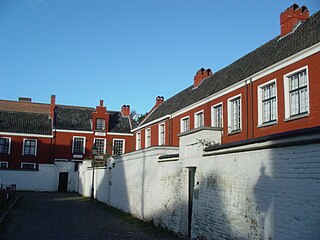
The small beguinage O.L.V. Ter Hooyen is situated in southern area of Ghent. This beguinage was built on the ‘Groene Hooie’, between the ‘Hooipoort’ and the ‘Vijfwindgatenpoort’. That is how this little beguinage got its name.
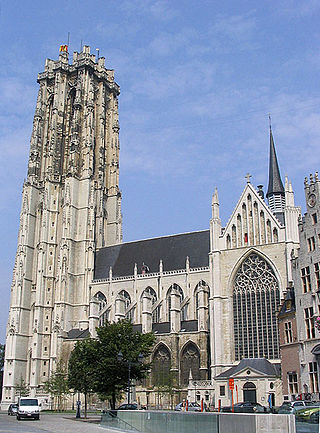
Brabantine Gothic, occasionally called Brabantian Gothic, is a significant variant of Gothic architecture that is typical for the Low Countries. It surfaced in the first half of the 14th century at St. Rumbold's Cathedral in the city of Mechelen.

The Church of St. John the Baptist at the Béguinage is a Roman Catholic parish church in central Brussels, Belgium. It is dedicated to Saint John the Baptist.
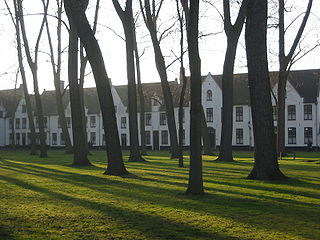
The Princely Beguinage Ten Wijngaerde is the only preserved beguinage in Bruges, Belgium. There are no more beguines living there, but since 1927, it has functioned as a convent for Benedictines, founded by canon Hoornaert. In the same year, the houses at the west side were also reshaped and enlarged into the Monasterium De Wijngaard, a priory of Benedictine nuns.
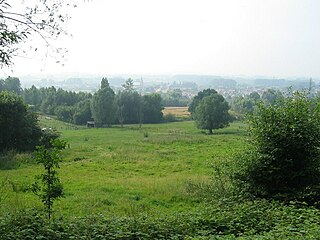
Ename is a Belgian village in the Flemish province of East Flanders. It stands on the right side of the river Scheldt and it is part of the municipality of Oudenaarde. The territory was inhabited during Prehistoric and Roman times, and became a trade settlement during the 10th century. From the 11th century it was part of the domain of the Benedictine abbey of Saint Salvator, until its 1795 dissolution in the aftermath of the French Revolution. The remains of the Saint Salvator abbey are today part of a major heritage project in Flanders, established by the Province of East-Flanders. The Provincial Archaeological Museum of Ename displays the major finds that have been excavated on the abbey site. Today the village of Ename hosts the Museumnacht in July and the Feeste t' Ename with the traditional horse market that has been held for centuries during the celebrations of the patron hallow Saint Laurentius, on the 10th of August.

The Campo Santo of Ghent, Belgium, is a famous Roman Catholic public burial ground in Sint-Amandsberg. The Campo Santo has been declared a historical monument by the government. This cemetery is located in the district of Dampoort.

Ten Duinen Abbey or the Abbey of the Dunes was a Cistercian monastery at Koksijde in what is now Belgium. It was one of the richest and most influential religious institutions in the medieval County of Flanders. It later relocated from Koksijde to the city of Bruges.

St. Stefanus is a Catholic parish church in Ghent, Belgium, part of an Augustinian monastery. It is dedicated to St. Stephen. The present building dates from 1841.

Saint Ivo's College was a college at the Old University of Leuven that provided accommodation and facilities for poor students in the Faculty of Law. The founder was Robertus de Lacu, originally from Ghent, who had been professor of canon law since 1463. The college was dedicated to Ivo of Kermartin, the patron saint of lawyers, and was used by the law faculty for faculty meetings and ceremonies. The original library was destroyed by marauding Spanish soldiers in 1578, during the Dutch Revolt.
The Major Seminary in Ghent was an institution for the training of Catholic clergy for the diocese of Ghent, first founded in 1569. It has been established at three different locations in the city. Since 2006 diocesan clergy from Ghent have been trained in Leuven.
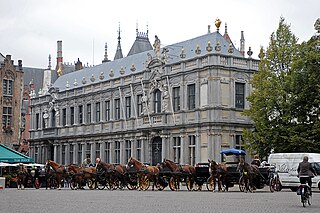
The Provostry of St. Donatian is a Baroque building on the Burg Square in Bruges, Belgium. Built in the 17th century, it served as the headquarters of the ecclesiastical seigniory of St. Donatian.

Zegelsem is a village in the municipality of Brakel in the province of East Flanders, Belgium. Zegelsem is an agricultural community in the Flemish Ardennes. It is located about 26 kilometres (16 mi) south of Ghent.
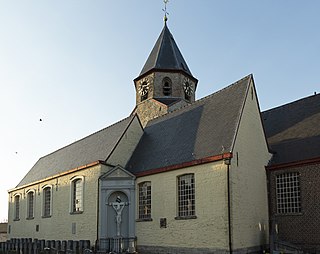
Ouwegem is a village and deelgemeente (sub-municipality) in the municipality of Kruisem in the province of East Flanders in Belgium. The village is located on the edge of the Flemish Ardennes and about 17 kilometres (11 mi) south-west of Ghent.

St Anthony of Padua Church or Rainbow Church is a Catholic church in Ghent, Belgium. It was constructed in Gothic Revival style in the years 1898–1900 to a design by architect Hendrik Geirnaert, as the parish church for the expanding 'Heirnis' section of the city. The new parish was established on 14 May 1896, but the Liberal majority on the local council initially opposed the building of a new church. The church was consecrated on 25 July 1901, by bishop Antoon Stillemans. The organ was built by Brussels organ maker Pierre Scheyven. It has been inventoried as built heritage since 1983.




















